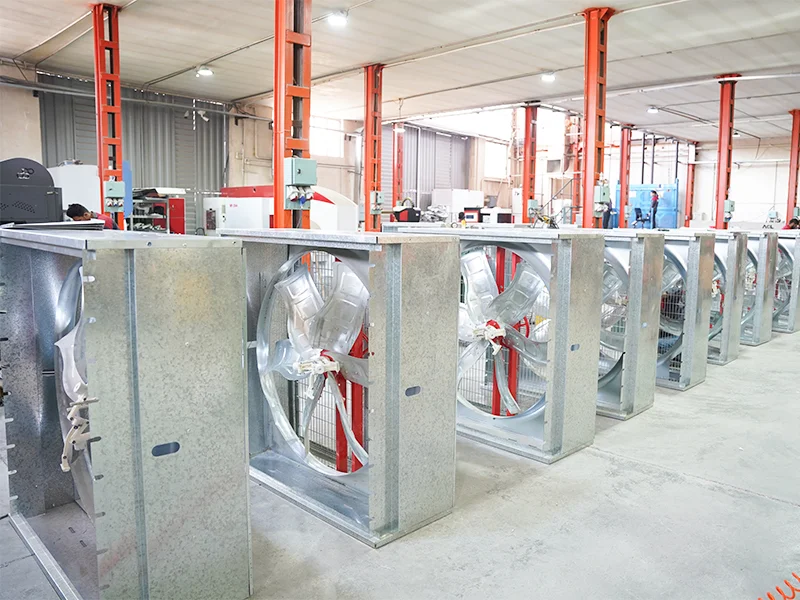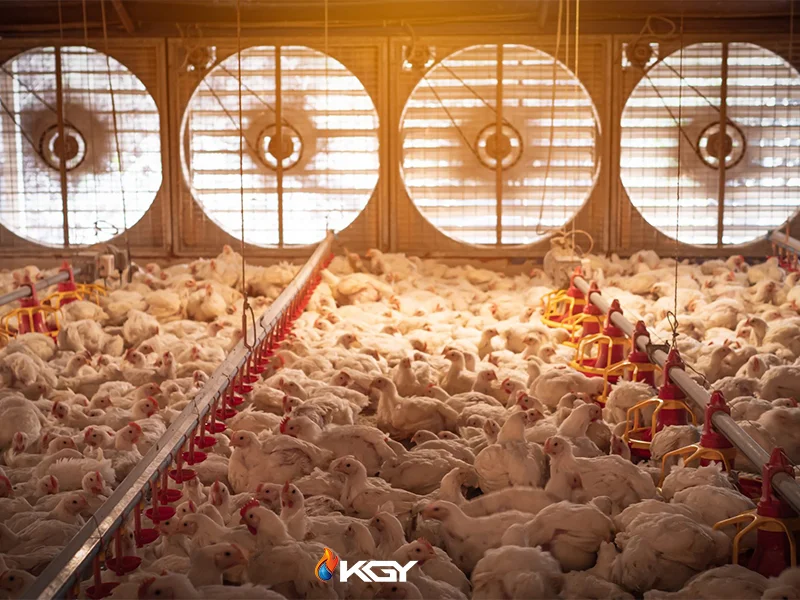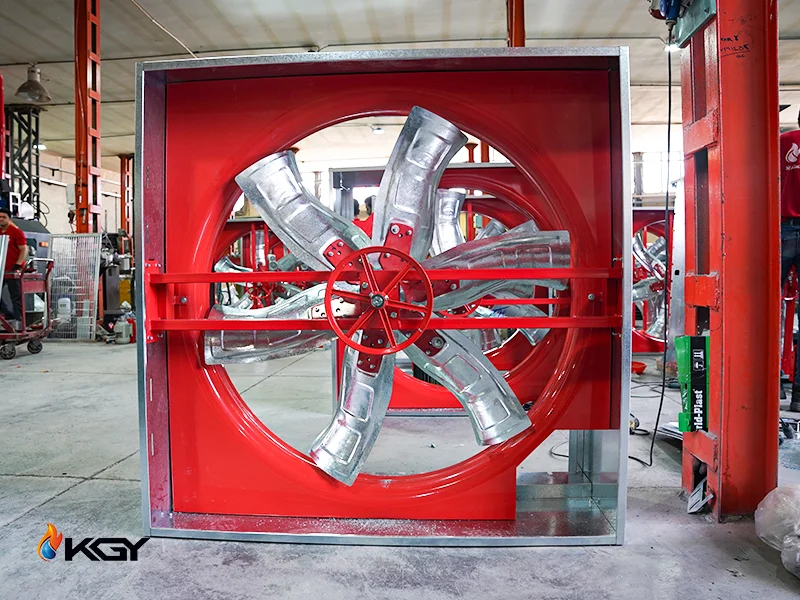In the world of poultry farming, fresh air is just as important as good feed and clean water. Poultry ventilation refers to the process of supplying fresh air and removing stale air, dust, and moisture from poultry houses. Proper poultry ventilation plays a critical role in maintaining a healthy and productive environment for your birds.
This article dives into the world of poultry ventilation. We'll explore why it matters, the different poultry ventilation systems available, and how to design and manage a poultry ventilation system that keeps your birds healthy and productive throughout their entire life cycle.
Table of Contents
ToggleWhy Poultry Ventilation Is Crucial
- Healthy Breathing: Chickens, like all living things, need fresh oxygen to breathe. Proper poultry ventilation removes harmful gases like carbon dioxide (CO2) produced by the birds themselves. This ensures there's enough clean air circulating in poultry farm.
- Ammonia: Chicken droppings release ammonia, a gas that can irritate the birds' respiratory system. Good poultry ventilation system helps remove this ammonia, preventing respiratory problems and keeping your birds healthy.
- Temperature & Humidity Control: Poultry houses can get hot and humid, especially with all those chickens! Proper ventilation helps remove excess heat and moisture, creating a comfortable environment for the birds. This is especially important during hot summers when chickens can suffer from heat stress.
- Disease Prevention: Stagnant air can harbor harmful bacteria and viruses. Good ventilation helps to dilute and remove airborne pathogens, reducing the risk of disease outbreaks in your flock.
- Happy Hens, Better Eggs: Believe it or not, happy chickens lay more eggs! A well-ventilated environment with fresh air and comfortable temperatures contributes to overall bird health and well-being, which can lead to increased egg production.

In short, proper ventilation in poultry houses is a win-win situation. It keeps your chickens healthy and comfortable, leading to better egg production and a more profitable poultry operation. By investing in a good ventilation system, you're ensuring the well-being of your flock and your own success as a poultry farmer.
Factors Affecting Ventilation Needs in Poultry Houses
We've established that proper poultry ventilation is key to happy and healthy chickens. But what exactly determines how much ventilation a poultry house needs? Several factors come into play:
- Number of Birds: It's pretty simple - the more birds you have, the more fresh air they need. Ventilation systems need to be sized to handle the amount of CO2 and ammonia produced by the flock.
- Bird Age: As discussed earlier, chicks have different needs than laying hens. Younger birds require a more controlled environment with minimal drafts, while older birds can tolerate more air movement.
- Climate: Hot and humid climates require more ventilation to remove excess heat and moisture. Conversely, colder climates might necessitate supplemental heating to maintain comfortable temperatures while still providing adequate ventilation.
- Building Design: The size and layout of the poultry house play a role. Larger buildings will need more powerful poultry ventilation systems to ensure proper air circulation throughout. Building materials and insulation levels also influence poultry ventilation needs.
- Activity Level: More active birds generate more heat and CO2. Factors like egg laying or feeding times can temporarily increase poultry ventilation requirements.
Essential Components of Poultry Ventilation Systems

We've explored the design considerations for effective poultry ventilation. Now, let's delve into the individual parts that work together to create a healthy and comfortable environment for your birds.
Exhaust Fans and Inlets
- Exhaust Fans: These electrically powered fans are the heart of mechanical poultry ventilation systems. Strategically placed fans draw out stale air, moisture, and harmful gases from the poultry house. Different fan types are available, each suited for specific airflow needs.
- Inlets: Inlets are openings in the walls or roof that allow fresh air to enter the poultry house. They can be fixed openings or adjustable curtains that allow for some control over airflow. Proper inlet placement ensures even distribution of fresh air throughout the house.
Curtains and Controllers
- Curtains: In naturally ventilated houses, sidewall curtains can be adjusted to control airflow. During mild weather, curtains can be opened to allow for natural poultry ventilation. Conversely, they can be closed to retain heat during cold periods.
- Controllers: Poultry ventilation systems often utilize electronic controllers. These devices monitor temperature, humidity, and other environmental factors within the poultry house. Based on pre-programmed settings, controllers automatically turn exhaust fans on or off and adjust inlet openings to maintain optimal air quality.
Environmental Sensors
- Sensors: These devices play a crucial role in collecting real-time data on various environmental factors within the poultry house. Common sensors include thermostats for temperature, hygrometers for humidity, and CO2 sensors for monitoring carbon dioxide levels. This data is fed into the ventilation controller, allowing for precise adjustments to maintain a healthy environment.
By working together, these components create a well-tuned system that ensures optimal air quality and bird comfort. In the next section, we'll provide some additional tips on maintaining your poultry ventilation system for peak performance.
Managing Ventilation Throughout the Flock Cycle

A well-designed poultry ventilation system is just the first step. To ensure optimal bird health and performance, proper ventilation management throughout the poultry production cycle is crucial. Here's how to adjust your ventilation based on the different stages of your flock's life:
Brooding Phase (Chicks 0-3 Weeks Old):
- Chicks are highly susceptible to temperature fluctuations.
- Maintain a warm and draft-free environment by using minimal ventilation with supplemental heat.
- Gradually increase ventilation as chicks mature to avoid moisture build-up.
Growing Phase (3 Weeks - Market Age):
- Focus on maintaining a comfortable temperature range for optimal growth.
- Adjust ventilation rates based on bird age and density.
- As birds grow, they generate more heat, requiring increased ventilation.
- Monitor humidity levels to prevent respiratory issues and ammonia buildup.
Laying Phase (Hens in Egg Production):
- Laying hens require a slightly cooler environment than growing birds.
- Maintain consistent ventilation to remove excess heat and moisture produced during egg production.
- Avoid drafts that can disrupt egg-laying behavior.
General Tips for Ventilation Management:
- Monitor Outside Weather Conditions: Adjust poultry ventilation based on outside temperature and humidity. During hot weather, increase ventilation to remove heat. Conversely, reduce ventilation during cold periods to conserve heat.
- Track Internal Environmental Factors: Regularly monitor temperature, humidity, and CO2 levels within the poultry house. This data helps you adjust ventilation settings to maintain optimal air quality.
- Maintain Equipment: Regularly clean and inspect ventilation system components like fans and inlets. Ensure proper functioning for optimal performance.
- Seek Expert Advice: Consulting with a poultry ventilation specialist can help you create a customized ventilation management plan for your specific needs and flock type.
By following these guidelines and adapting poultry ventilation settings throughout the production cycle, you can create a healthy and comfortable environment for your birds, leading to improved bird health, better productivity, and ultimately, a more profitable farm.
Monitoring and Maintaining Your Poultry Ventilation System
Just like a car needs regular tune-ups, your poultry ventilation system also requires monitoring and maintenance to ensure it operates efficiently and delivers optimal air quality for your flock. Here's why regular attention is crucial:
Why Monitoring Of The Poultry Ventilation Matters:
An efficient poultry ventilation system translates to healthy birds and a productive farm. Regular monitoring allows you to identify and address potential issues before they impact your flock's health. Here's what to watch for:
- Environmental Sensors: Pay close attention to readings from temperature, humidity, and CO2 sensors. Deviations from ideal ranges indicate potential poultry ventilation problems.
- Airflow Patterns: Regularly observe air movement within the poultry house. Uneven airflow patterns or stagnant areas suggest poultry ventilation system malfunction.
- Bird Behavior: Listless birds panting excessively or huddled together can be signs of inadequate ventilation and overheating.
Common Ventilation Problems and Fixes
Even the best poultry ventilation systems can encounter occasional hiccups. Here are some common problems and their solutions:
- Improper Airflow: Uneven distribution of fresh air or stagnant areas can be caused by blocked inlets, malfunctioning fans, or incorrect system design. Consulting a specialist can help diagnose the issue and recommend solutions.
- Insufficient Ventilation: High humidity, excessive heat, or rising CO2 levels indicate insufficient ventilation. Check for clogged filters, malfunctioning fans, or undersized ventilation systems. Adjustments or upgrades might be necessary.
- Drafts: Drafts can cause discomfort and stress birds. Ensure proper inlet placement and adjust airflow patterns to eliminate drafts.
Maintaining Peak Performance
Here are some essential maintenance tips to keep your poultry ventilation system operating at its best:
- Regular Cleaning: Clean dust and debris from fans, inlets, and filters to ensure proper airflow.
- Inspect Equipment: Regularly inspect fans, inlets, and controls for signs of wear and tear. Address any issues promptly to avoid breakdowns.
- Test and Calibrate: Periodically test and calibrate sensors and controllers to ensure they provide accurate readings.
By monitoring your poultry ventilation system for signs of trouble and implementing a regular maintenance routine, you can prevent costly breakdowns and ensure your birds have access to the fresh air they need to thrive. Remember, a well-maintained ventilation system is an investment in the health and well-being of your flock, leading to a more successful and profitable poultry farm.
KGY Exhaust Fans: Power Up Your Poultry Ventilation
Looking for an exhaust fan that tackles even the toughest environments? KGY Exhaust Fans deliver unmatched performance with features designed to keep your poultry house cool, clean, and efficient.

Here's what sets KGY Exhaust Fans apart:
- Unmatched Airflow Power: Blast away heat and stale air with a phenomenal 36,000 cubic meters per hour aeration capacity. No matter the starting temperature, KGY fans create a comfortable and productive zone in poultry farms.
- High-Pressure Performance: designed for high Pascal pressures, KGY fans effectively push air through long ducts and overcome resistance, ensuring powerful ventilation even in complex layouts.
- Durable Construction: Built to last with hot-galvanized steel, high-quality bearings, and a double chassis for superior strength and long-lasting performance.
- Simplified Maintenance: Hinged wire doors and easy-access features allow for effortless cleaning and maintenance, saving you valuable time and effort.
- Temperature Control You Can Count On: KGY fans efficiently reduce indoor temperatures to less than 30 degrees Celsius, regardless of the initial heat.
- Mounting Flexibility: KGY fans offer both wall and window mounting options for maximum adaptability.
- Smooth, Quiet Operation: High-quality UCF bearings and a belt tensioner ensure smooth operation and minimal noise, promoting a peaceful poultry environment. The double chassis design further reduces vibrations for a rattle-free experience.
- Built to Last: Heavy-duty construction with high-quality bearings and die-cast pulleys guarantees long-lasting performance and minimal maintenance needs.
KGY Poultry Exhaust Fans: The Key To A Cooler, Cleaner, And More Productive Poultry House
Contact us today to learn more about how KGY Exhaust Fans can transform your space.
FAQ
Proper poultry ventilation removes moisture, ammonia, and dust, maintaining good air quality for bird health.
Balancing temperature control with removing excess moisture, especially in winter.
Tunnel ventilation: draws air through the house from inlets to fans.
Bird age, type, stocking density, and local climate.
Regularly clean the system, adjust settings seasonally, and ensure proper equipment function.

